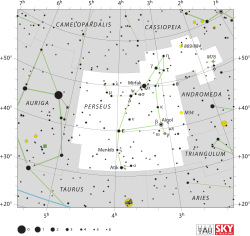Epsilon Persei
| Observation data Epoch J2000 Equinox J2000 | |
|---|---|
| Constellation | Perseus |
| Right ascension | 03h 57m 51.23205s[1] |
| Declination | +40° 00′ 36.7752″[1] |
| Apparent magnitude (V) | +2.88[2] |
| Characteristics | |
| Spectral type | B0.5 V+[3] |
| U−B color index | –0.96[2] |
| B−V color index | –0.20[2] |
| Variable type | β Cep[4] |
| Astrometry | |
| Proper motion (μ) | RA: +14.06[1] mas/yr Dec.: –23.78[1] mas/yr |
| Parallax (π) | 5.11 ± 0.23 mas[1] |
| Distance | 640 ± 30 ly (196 ± 9 pc) |
| Orbit[5] | |
| Companion | ε Per B |
| Period (P) | 14.06916 ± 0.00004 days |
| Eccentricity (e) | 0.5549 ± 0.0093 |
| Periastron epoch (T) | 47767.543 ± 0.024 |
| Argument of periastron (ω) (secondary) | 105.8 ± 1.2° |
| Semi-amplitude (K1) (primary) | 15.23 ± 0.20 km/s |
| Details | |
| ε Per A | |
| Mass | 13.5 ± 2.0[5] M☉ |
| Radius | 7.66[3] R☉ |
| Luminosity | 28,330[6] L☉ |
| Temperature | 26,500[6] K |
| Rotational velocity (v sin i) | 155 ± 20[3] km/s |
| Age | 15.4 ± 0.6[7] Myr |
| ε Per B | |
| Mass | 0.85–1.77[5] M☉ |
| Radius | 1.4 ± 0.4[5] R☉ |
| Rotational velocity (v sin i) | 300 ± 30[3] km/s |
| Other designations | |
| Database references | |
| SIMBAD | data |
Epsilon Persei (ε Persei, ε Per) is a multiple star system in the northern constellation of Perseus. It has a combined apparent visual magnitude of +2.88,[2] which is bright enough to be viewed with the naked eye. Based upon parallax measurements, this system is located at a distance of roughly 640 light-years (196 parsecs) from Earth.[1]
This is a spectroscopic binary system, which means that the presence of an orbiting companion has been revealed by radial velocity variations in the spectrum of the primary. The two components are orbiting each other with a period of 14 days at a high orbital eccentricity of 0.55. The secondary component has about 6–13% of the primary's mass and may have a stellar classification in the range from A6 V to K1 V. There may be a third component to this system with an orbital period of roughly 9,428 days (25.8 years), although this has not been conclusively demonstrated. If this component exists, it would have about 51–139% of the primary's mass. This high level of uncertainty is because the inclination of the orbit is not known.[5]
The primary component of this system, Epsilon Persei A, is a massive star with 12–16[5] times the Sun's mass and near eight times the radius of the Sun.[3] It has a stellar classification of B0.5 V,[3] making it a B-type main sequence star that is generating energy at its core through the nuclear fusion of hydrogen. Component A is radiating over 28,000[6] times the Sun's luminosity from its outer envelope at an effective temperature of 26,500 K.[6] This gives the star the blue-white hue that is typical of B-type stars.[9]
Epsilon Persei A is a Beta Cephei variable star with a primary pulsation period of 0.1603 days, or 6.24 cycles per day. It may have multiple pulsation frequencies.[4]
References
- ^ a b c d e f van Leeuwen, F. (November 2007), "Validation of the new Hipparcos reduction", Astronomy and Astrophysics, 474 (2): 653–664, arXiv:0708.1752, Bibcode:2007A&A...474..653V, doi:10.1051/0004-6361:20078357
- ^ a b c d Lutz, T. E.; Lutz, J. H. (June 1977), "Spectral classification and UBV photometry of bright visual double stars", Astronomical Journal, 82: 431–434, Bibcode:1977AJ.....82..431L, doi:10.1086/112066
- ^ a b c d e f Howe, K. S.; Clarke, C. J. (January 2009), "An analysis of v sin (i) correlations in early-type binaries", Monthly Notices of the Royal Astronomical Society, 392 (1): 448–454, Bibcode:2009MNRAS.392..448H, doi:10.1111/j.1365-2966.2008.14073.x
- ^ a b Stankov, Anamarija; Handler, Gerald (June 2005), "Catalog of Galactic β Cephei Stars", The Astrophysical Journal Supplement Series, 158 (2): 193–216, arXiv:astro-ph/0506495, Bibcode:2005ApJS..158..193S, doi:10.1086/429408
- ^ a b c d e f Libich, J.; et al. (February 2006), "The new orbital elements and properties of ɛ Persei", Astronomy and Astrophysics, 446 (2): 583–589, Bibcode:2006A&A...446..583L, doi:10.1051/0004-6361:20053032. Results per solution 6.
- ^ a b c d Hohle, M. M.; Neuhäuser, R.; Schutz, B. F. (April 2010), "Masses and luminosities of O- and B-type stars and red supergiants", Astronomische Nachrichten, 331 (4): 349, arXiv:1003.2335, Bibcode:2010AN....331..349H, doi:10.1002/asna.200911355
- ^ Tetzlaff, N.; Neuhäuser, R.; Hohle, M. M. (January 2011), "A catalogue of young runaway Hipparcos stars within 3 kpc from the Sun", Monthly Notices of the Royal Astronomical Society, 410 (1): 190–200, arXiv:1007.4883, Bibcode:2011MNRAS.410..190T, doi:10.1111/j.1365-2966.2010.17434.x
- ^ "eps Per -- Variable Star of beta Cep type". SIMBAD. Centre de Données astronomiques de Strasbourg. Retrieved 2012-01-25.
- ^ "The Colour of Stars", Australia Telescope, Outreach and Education, Commonwealth Scientific and Industrial Research Organisation, December 21, 2004, archived from the original on 2012-03-10, retrieved 2012-01-16

